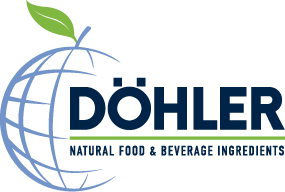Pure Elegance – Black coloured food
The first perceivable property of a product is its colour. Colours influence the perception of consumers with regards to naturalness, flavour and sweetness of a product and therefore play a vital role in the purchasing decision. Whether black burgers, fruit gums or ice cream – black-coloured food are real eye-catchers at every meal. They are not only taking over Instagram, but are also hugely popular in supermarkets.
Over the last few years, the “naturalness” of food and beverages has become one of the most important attributes in the food industry. The main goal is therefore to capture the most vibrant colours in nature to create unique, multi-sensory experiences. The path to the right colour begins with growing high-quality and colour-intensive plant-based raw materials in a sustainable way, to processing them using gentle cutting-edge, sustainable technologies and developing customised colour solutions for each food and beverage application.
In light of this, Döhler, a global producer, marketer and provider of technology-driven natural ingredients, ingredient systems and integrated solutions for the food and beverage industry, offers a wide range of natural colours, including the current trend colour black.
Black – a colour with many different facets
Choosing the right colour is essential for the success of a product. Colours must not only be tailored to fit the overall multi-sensory concept, but also be in line with the product positioning and suitable for the application. Every single application requires customised solutions to achieve a vibrant result which remains stable throughout the entire shelf life of the product.
The colour black is associated with characteristics such as noble, festive, luxurious, courageous, strong, impressive or mysterious. Consumers connect it less with foods than colours such as yellow, orange, red or green hues. There are, though, naturally occurring fruits and vegetables with a black appearance, such as blackcurrant, blackberry, black lentils, or eggplants. In addition, some traditional processed foods also come along in black, such as black pasta, licorice and some hard-boiled candies. And let’s not forget coffee and black olives!
The basis for the dark appearance of fruits and vegetables is red-purple pigments belonging to the anthocyanin family, giving an appearance of black because of their high concentration in the skin. For black products there are some examples: Coffee gets its black colour – which is actually a very intense brown – by roasting. Black pasta is coloured through the addition of squid ink, contributing to its fishy taste, and is in fact also a very dark brown. Confectionery products are coloured with vegetable carbon (E 153) or charcoal, and olives are turned black by the addition of ferrous salts (E 579 or E 585) which interact with the polyphenols of the green olive. All these options produce different shades of black, so that one is tempted to adapt a saying of the designer Rei Kawakubo1: “Nature works in several shades of black.”
The colour black – the new trend on the food and beverage market
Recently black food has become even more vogueish and products such as black bread, black burger buns, black pizza or even black cheese have appeared on the market. The black colour of these food products is based on artificial colours or on the use of vegetable carbon, neither of which meets consumer expectations or is globally acceptable.
A natural alternative to the currently used black food colours is therefore a priority for the food industry, which needs to meet the following criteria:
- Naturally derived, ideally plant-based
- Clean label declaration
- Globally regulatory approved
- Useable in a wide range of food products and processes
- Minimal taste and mouthfeel impact
Natural Black Colour Solutions from Döhler
Döhler has developed a range of natural black solutions which can be used in a wide range of food categories around the globe. The company offers the first generation of natural black based on coloured foods. It is orientated towards the confectionery industry and is a replacement for vegetable carbon, a food colouring with the E number E 153. Döhler is therefore able to offer a new solution to the food industry based on coloured foods, and one which is in line with the consumer demand for more naturalness in food.
Regulatory, processing and food system challenges
Unfortunately, not all of the natural colours or colouring foods which can be used for a subtractive colour mix are allowed in every country. Finding a single, globally accepted solution for natural black products is therefore a huge challenge, as it depends on the country-specific food legislation governing which natural black solutions can be used in certain foods.
Furthermore, not all natural colours react in the same way towards differences in the composition of a given food product, in respect to, for instance, acidity, water activity or processing temperature.
Integrated Natural Colour Solutions
Döhler’s colouring solutions are based on pure natural plant-based products, with the colours being extracted from fruits, cereals, vegetables, malt or other plant-based raw materials. Vegetables are particularly well suited as a raw material in the production of natural colours because they remain stable despite light, heat and other chemical and physical influences.
As a provider of complete ingredient systems and integrated solutions, Döhler’s primary focus is on the development of innovative concepts. In line with the company slogan “We bring ideas to life.”, Döhler develops custom complete solutions, processes and innovations for its customers – from the field to the supermarket shelves.
1Rei Kawakubo: „I work in three shades of black“
